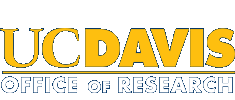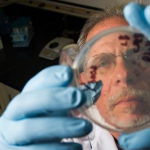UC Davis Granted $15.5 Million to Build World’s First Total-Body PET Scanner
By Jocelyn Anderson
A research team at UC Davis is set to build the world’s first total-body positron emission tomography (PET) scanner — one that could fundamentally change the way cancers and other diseases are diagnosed and treated with the added benefit of a reduced radiation dose that is roughly equivalent to that received on a roundtrip flight between San Francisco and London.
Thanks to a five-year, $15.5 million Transformative Research Award from the National Institutes of Health, the team will get the chance to build a full-size prototype, which could put the university on the nation’s leading edge of molecular imaging.
The EXPLORER project, led by Simon Cherry, distinguished professor of biomedical engineering, and Ramsey Badawi, professor of radiology, has been in the works for 10 years. The award now comes at a time when technology has caught up with the vision, making it possible to efficiently process all the data generated from the half a million detectors needed for a total-body scanner.
After the scanner is completed and studies in humans commence, the researchers hope their technology will lead to new discoveries about the human body and even launch a whole diagnostic field.
“This could be a total game-changer,” said Ralph de Vere White, director of the UC Davis Comprehensive Cancer Center. “If this works, it’s going to change medicine. It’s going to change cancer detection and how we evaluate therapies.”
Pioneers in Imaging
PET scans are widely used to diagnose and track a variety of diseases, including cancer, because they show how organs and tissues are functioning in the body (in contrast to MRI or CT scans, which mostly show anatomy). Using radioactive tracers that produce a signal from within the body, PET scanners produce a three-dimensional image that is constructed by computers using sophisticated mathematical techniques. The EXPLORER project would address shortcomings of the current scanning technology, which requires more time and exposes the patient to more radiation because scans are done in 20-cm segments.

Simon Cherry
“The vision of the EXPLORER project is to solve two fundamental limitations of PET as it is currently practiced,” said Cherry. “The first is to allow us to see the entire body all at once. The second huge advantage is that we’re collecting almost all of the available signal, which means we can acquire the images much faster or at a much lower radiation dose. That’s going to have some profound implications for how we use PET scanning in medicine and medical science.”
Cherry and Badawi predict that by seeing the entire body simultaneously, their scanner could drop the radiation dose by a factor of 40 or decrease scanning time from 20 minutes to just 30 seconds. A quicker scan also could reduce the incidence of images blurred by patient movement, resulting in images with more detail.
The technology would have implications in diagnostics, treatment and also drug development. With whole-body PET, physicians could diagnose a disease and then follow its trajectory in a way never before possible and that could affect how patients are treated. This approach reflects the current trend in medicine to develop systems-based treatments and more individualized care.

Ramsey Badawi
Additionally, pharmaceutical companies could use the scanner to show how drugs and compounds are transported through the body and determine whether a drug is targeting the disease or whether it goes to other organs, where it could cause harmful side effects.
“There are many questions that we couldn’t possibly ask before — and now we will be able to ask them,” Badawi said. “This is not just a big instrumentation grant. It’s going to give us a tool that will allow us to see things we’ve never seen before.”
Cherry and Badawi are joint principal investigators. The team also includes Jinyi Qi, professor of biomedical engineering, who leads the computational aspects of the project, and Terry Jones, volunteer clinical faculty in diagnostic radiology, who has developed some of the key potential biomedical applications for the scanner and will be directly involved in planning the early uses of the EXPLORER technology for human imaging studies.
RISE-ing To the Challenge
Fundamental research for the EXPLORER project was made possible by the UC Davis Research Investments in the Sciences and Engineering program, which was designed to provide preliminary backing for large-scale, and potentially groundbreaking, interdisciplinary research activity at the university.
The program, funded by the university’s Office of Research in 2012, supported 13 collaborative investigational projects with an investment of $10.9 million over a three-year period. The program, now in its third year, has a 10-to-1 return on investment.
“Our intended outcome of this program was to give faculty teams an edge when they went to compete for funding,” said Harris Lewin, vice chancellor for research at UC Davis. “The EXPLORER team is an example of the tremendous success that can come when we support early-concept ideas that have the potential to make an impact on society.”
The EXPLORER team is an example of the tremendous success that can come when we support early-concept ideas that have the potential to make an impact on society.” — Vice Chancellor Harris Lewin
Cherry and Badawi, with radiochemistry collaborator Julie Sutcliffe, were awarded an inaugural RISE grant to address the limitations of medical imaging, namely the current PET technology. Over the past three years, the group has completed preclinical testing of a novel molecular imaging agent for cancer, readied the facility for producing the first batches of human-grade radiolabeled peptides and produced designs and computer simulations for the total-body scanner.
“The funding of the RISE program was critical,” said Cherry. “In combination with another feasibility grant from the National Cancer Institute, the RISE grant really enabled us to put the team together and to get enough preliminary data to solidify the idea to the point where we could convince a peer review group at NIH to fund it.”
Added Badawi: “Basically, we had to convince the doubters and proactively demonstrate the possibilities. Without RISE, I don’t think that would have been possible. There is no doubt that we can pin this success to the RISE program.”
Down the road, the team hopes to see the technology commercialized, ultimately making it available to hospitals and researchers worldwide.
“This is the project of my career, no question,” said Cherry. “It’s an amazing privilege and responsibility to work on something of this scale that has the potential to have so much impact in biomedical research and health.”
Additional resources:
Simon Cherry photo for download.
Media contacts:
AJ Cheline, UC Davis Office of Research, 530-752-1101, [email protected]
Dorsey Griffith, UC Davis Comprehensive Cancer Center, 916-734-9118, [email protected]
Andy Fell, UC Davis News Service, 530-752-4533, [email protected]





